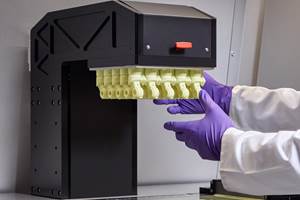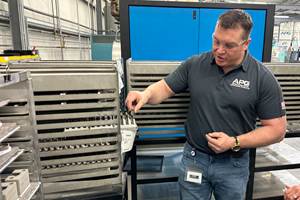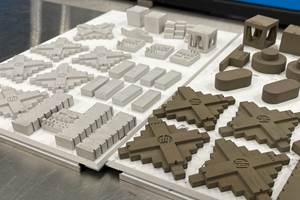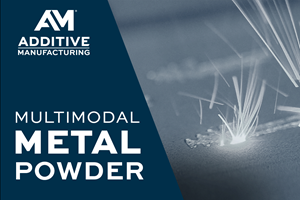Video: What is Selective Laser Sintering?
SLS is a powder-bed process for building polymer parts. How does it work and what can it do? AM talks SLS with Farsoon.
Selective laser sintering (SLS) is a powder-bed process for building polymer parts. How does SLS work and what can it do? I talked about this with Chuck Kennedy of Farsoon.
Transcript
Peter Zelinski, Additive Manufacturing
3D printing is getting more effective at producing large parts. It's also introducing new options for producing large parts at large quantities, particularly quantities not quite large enough to justify mold tooling. I talked about this with Chuck Kennedy of Farsoon. Chuck, you brought in a really big part here. What is this?
Chuck Kennedy, Farsoon
It's a Selective Laser Sintering part, built in our new model HTC 1001 P, and this is our standard nylon, pa 12 material that we make at our factory as well. We manufacture the material as well as the machines.
Peter Zelinski
This is an HVAC see component.
Chuck Kennedy
Yes, it's a HVAC component for one of our partners in China. It's a global company that they just happen to be manufacturing the HVAC components there. It used to be that this was a molding application, so they'd create multiple molds and inserts to be able to push this out.
Peter Zelinski
It was formerly injection molded in all one piece, like this?
Chuck Kennedy
No, actually it's probably about a two or three piece mold. So they consolidated it through design, when you look at the complexity of this part, you can see that there, there's a lot of hidden channels under cuts, those type of things. All those things require some level of tooling to be able to create a mass production type of part. So they were able to simplify some of that design, and then through additive, they were able to do this in one piece. This piece took about 10 hours. So this manufacturers in about 10 hours.
Peter Zelinski
Do you know why the manufacturer arrived at 3D printing as the alternate process for this part? Was there a particular challenge of this component when it was molded? Or was it a particularly difficult part?
Chuck Kennedy
So when you took at just general additive or tool and injection molding, you gotta amortize the cost of those tools over time. So if you're looking at a tool that maybe costs $500,000 to do, you've got to amortize that over so many components, and it ends up being into that, you know, close to a million component type of amortization. You know, they may not have a car that's in that life cycle, that they're going to sell that many units. That's how they kind of derived the per piece aspect of the costs. We've got a limited volume of these cars and we only need you know, 50,000 of these parts over the next five years or three years. You know, do we want to spend this amount on tooling, or let's just produce the part in additive? This also allows them to come back ... making slight design changes. They can make those changes on the fly and improve things as the life of the car is out there.
Peter Zelinski
Those who are familiar with additive are not so surprised by the complexity of this part, we're very familiar with seeing complex parts made additive Lee, but we're not necessarily familiar with additive being made for a production part, or a part at this scale. Let's talk about the size first. Are there technology advances or improvements that have made it practical to do SLS for a part of this big?
Chuck Kennedy
Yeah, and it kind of starts with the scanners and the lasers. So there's some technical advantages with scanning systems and selective lasers centering because of the accuracy of the Galbo systems. So it allows you to meet accuracies that you normally would only get out of injection molding. So when you're talking about those levels, and it's scalable, this is scalable to the point where we could add four lasers, eight lasers, eight scanners to really scale this up for larger production as well.
Peter Zelinski
You mentioned 10s of thousands of units, perhaps. What does the additive manufacturing system or platform look like that takes apart like this and repetitively produces it at production scale?
Chuck Kennedy
Picture a conveyor belt system. This system alone has a pre-heat station, so you have your cartridge in there that's being pre-heated, then you have your build station. After this finishes, it moves over to an automated cooling station, and then it allows the next chamber to come in into the build station already pre-heated, and then starts up your next build. So, it truly gets to that point where you're doing chain production.
Peter Zelinski
What is your sense of what that will mean? This is 3D printing as an alternative to injection molding. How far can 3D printing go as a production process for parts like this?
Chuck Kennedy
The big gap there is the raw material costs. You know, additive materials are still at a point where the per kilo price of powders is significantly higher than pellets, for instance. The initial phases are going to really be designed around custom limited quantities. Picture some of the custom cars that are out there that they're only going to do 1,000 cars. When you talk about things like widgets, or gears or those type of things ... take something that requires three or four parts to be screwed together. Now, through additive, you can do it in one part and you can fit 1,000 of them onto a build tray. There's your value in getting out of that injection molding set. But big parts like this? It's going to be very much custom into low volume, highly complex parts.
Related Content
Admatec’s Larger Integrated Binding/Sintering Furnace for Ceramic 3D Printing
Company scales up for more efficient mass customization and serial ceramics 3D printing production lines.
Read MoreSinter-Based Additive Manufacturing Finds a Place Alongside MIM, Press and Sinter at APG
Powder metallurgy company Alpha Precision Group (APG) is applying a particular class of metal 3D printing technology for both rapid iteration in development and flexibility in production.
Read MoreWhat Is the Role of Sintering in Binder Jetting? (Video)
And how strong are green parts prior to sintering? Filmed at HP, here is a look at sintering, including the shrinkage from green to sintered binder jet parts.
Read MoreVideo: Multimodal Powders for Metal 3D Printing
Rather than uniform particle diameters, multimodal powders combine particles of different sizes. In this video, how and why Uniformity Labs produces multimodal metal powders for additive manufacturing.
Read MoreRead Next
Video: Selective Laser Sintering for Production of Large Parts
SLS offers a production option enabling large, precise plastic parts to be made cost-effectively in quantities generally too low for injection molding.
Read More3D Printing Brings Sustainability, Accessibility to Glass Manufacturing
Australian startup Maple Glass Printing has developed a process for extruding glass into artwork, lab implements and architectural elements. Along the way, the company has also found more efficient ways of recycling this material.
Read MoreHybrid Additive Manufacturing Machine Tools Continue to Make Gains (Includes Video)
The hybrid machine tool is an idea that continues to advance. Two important developments of recent years expand the possibilities for this platform.
Read More





















